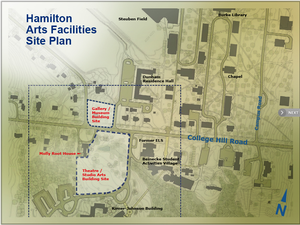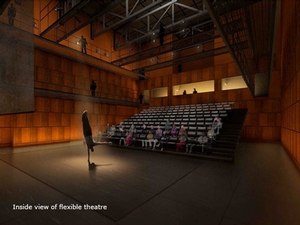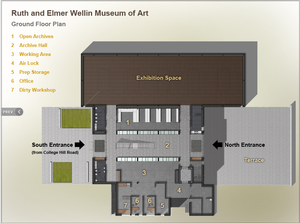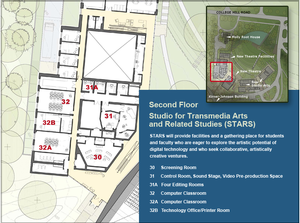Bicentennial Initiative funds new arts facilities
Construction of new studio arts building, theater complex,
teaching museum planned
by Allison Eck '12
MANAGING EDITOR
Follow the steps down to the Dunham Residence Hall basement and a Hamilton student might be surprised to find several art studios.
Fortunately, these studios will relocate upon the completion of a proposed studio arts space that is part of a large-scale plan to revamp the arts at Hamilton. Once this technologically advanced space is constructed, students will finally have the resources necessary to capture and dramatize ideas in the visual arts more effectively, and with fewer headaches along the way.
The plans fall under the umbrella of the Bicentennial Initiatives, a $117 million capital campaign that was launched publicly Friday, Dec. 3, at the college’s annual 1812 Leadership Circle Weekend in New York City. Lenord C. Ferguson Professor of Music Sam Pellman said that the plans for new arts facilities (which include the studio arts building, a theater complex and a teaching museum) were originally conceived about 10 years ago.
“We were completing a Mid-States Re-Accreditation Review and starting a Strategic Planning process, and [former] President Tobin asked me to get a group together to talk about arts facilities — it had come to his attention that there were some serious deficiencies, so he wanted to make sure that planning for that was going to be part of the Strategic Plan,” Pellman said.
Because the music department’s facilities had recently been overcome with the addition of Wellin Hall, Pellman took the lead as Faculty Coordinator of Arts Facilities Planning so as to ensure that his colleagues’ facilities would soon match the quality of his own. The decision to make the project part of the Bicentennial Initiatives was largely President Stewart’s doing.
“I think this is something that President Stewart believes in very, very much and it was her guidance that brought the Arts Initiative to this level of attention,” Pellman said. The College is now seeking to raise $35 million to construct the three facilities.
History of the arts at Hamilton
The impetus for the Arts Initiative came from the recognition that current facilities for studio art, theater and dance have become severely outdated. List Art Center was constructed in 1970, before Kirkland College had hired its faculty, which meant that the building was designed with very little professorial or administrative input, giving rise to many structural inconveniences. Corridors have become storage rooms and teaching spaces, ventilation is poor, and students must make unnecessary trips to cart materials to and from various classrooms. Direct sunlight infiltrates the painting studio that faces the west side of campus.
“Not quite the way you would want to introduce natural light into a space,” Pellman said. “A lot of the really serious or hazardous issues have been addressed, but I would say it’s all been sort of jury-rigged.”
Visual art departments on campus have survived on the notion that they can modify spaces to suit their needs. For example, Professor of Theatre Craig Latrell says that aside from Minor (which was previously an infirmary, and then a library), the department has only one dedicated lab space, used for classes, rehearsals and workshop performances.
“And yet, year after year, theater students and faculty have managed to overcome these difficulties to produce truly exciting, imaginative and diverse theater with high design and production standards,” he said. “We look forward immensely to the new theater facility precisely because it will not throw up obstacles to our work, but will instead facilitate it.” Another problem with the current facilities is that many of the departments’ work spaces are spread across campus. For instance, the Dunham basement has played host to a substantial portion of the Hamilton Art Department since 1958, when it was built. Although most classes and studios are now located in List, the Dunham studios are still set aside for several senior art concentrators.
Associate Professor of Art Rebecca Murtaugh says that although the College renovated the Dunham basement three years ago, the separation from List is still less than ideal — “[it] limits dialogue and peer learning,” she said.
“You want artists to be together and bounce ideas off each other, and be each other’s worst critics, so I think it’s really important to pull this all together,” Pellman noted.
New facilities, new opportunities
The plans for the studio arts space are tentative but include large common areas for critiques and temporary exhibitions, smaller workshops and classrooms (including 14 senior studios) and a Studio for Trans-media Arts and Related Studies (STARS), an interdisciplinary space focused on applications of digital technology in the arts.
The new theater facility will consist of a main theater and a smaller theater for visiting artist presentations or senior projects. It will also provide students with expanded dressing rooms and costume shops. The current costume shop is a closet that used to house WCHL before it moved to Bristol.
 In addition, a $10 million lead gift from Keith Wellin ’50 and his wife Wendy is allowing the College to begin construction on a new 30,000-square-foot museum next spring. Named in honor of Mr. Wellin’s parents, the Ruth and Elmer Wellin Museum of Art will be a creative “ teaching laboratory” where, according to a Dec. 4 article on the Hamilton website, “students are encouraged to ask questions, make connections to disciplines far beyond the arts, and develop visual literacy skills critical to life and learning in the 21st century.”
In addition, a $10 million lead gift from Keith Wellin ’50 and his wife Wendy is allowing the College to begin construction on a new 30,000-square-foot museum next spring. Named in honor of Mr. Wellin’s parents, the Ruth and Elmer Wellin Museum of Art will be a creative “ teaching laboratory” where, according to a Dec. 4 article on the Hamilton website, “students are encouraged to ask questions, make connections to disciplines far beyond the arts, and develop visual literacy skills critical to life and learning in the 21st century.”
The museum will include open archives where students can gather for discussion and a 48-seat classroom with high quality projection. A closed archive nearby will include two seminar tables and projection equipment.
Although all the plans are not set in stone, the general layout will be the same as depicted in the diagrams. “Basically what the architect is working on now is trying to squeeze things together so the footprint of the building is not so big and we can save quite a few million dollars,” Pellman said.
Students have expressed excitement about the new facilities, despite that most of them will graduate before their completion.
“Although the studio in List 104 has been a second dorm room for me during my years at Hamilton, and the Events Barn has its charm as a performance space, the exclusivity of Minor Theatre for the main stage productions has made the search for rehearsal and playing space a little more difficult than it should be,” said Ryan Park ’12. “I am excited for the construction of an arts facility that will match the standard of excellence for which Hamilton’s Theatre Department is known.”
Pellman voiced a similar sentiment: “I think it’s a recognition by Hamilton of the important role the arts have played here, but more importantly, a recognition of the role the arts will play in the future.”
